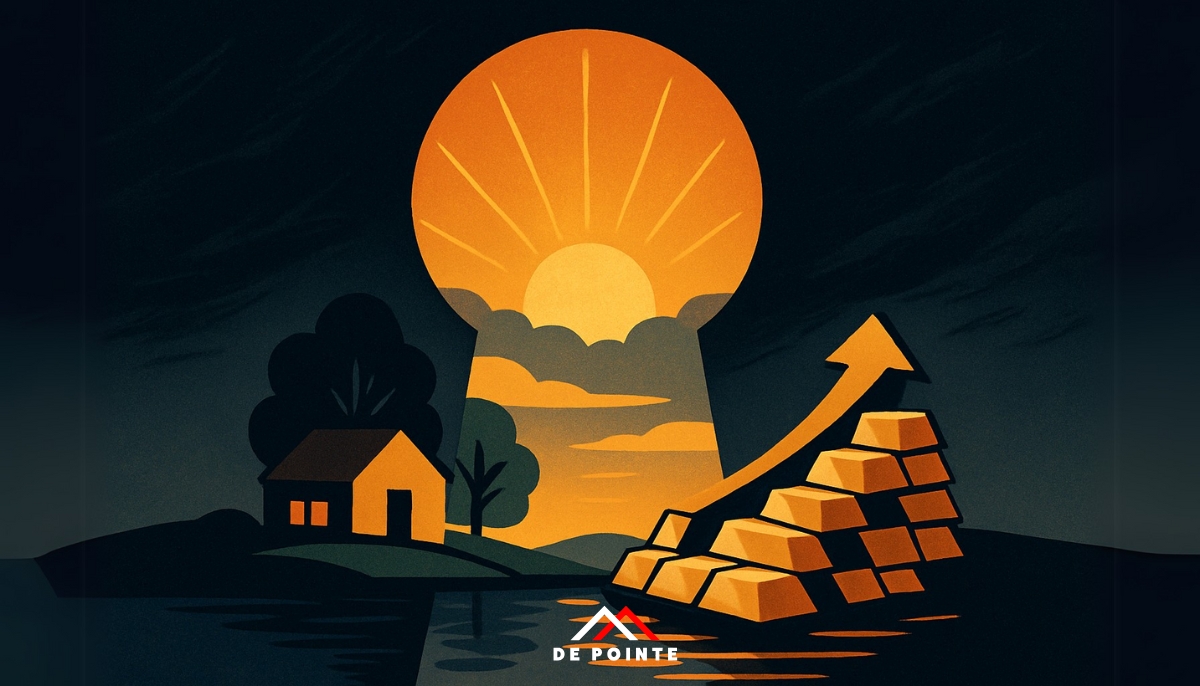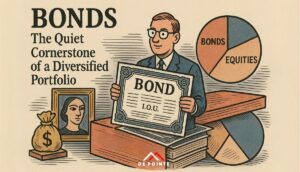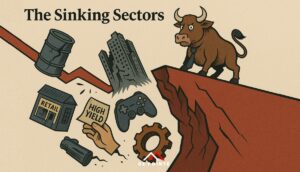Article

With volatility at a five-year high amid trade wars and massive geopolitical instability, more people than ever are turning to safe havens to protect and even grow their wealth. This exodus to safe-haven assets is one of the main driving forces behind the phenomenal growth the gold market has seen over the past few years.
Now, with Gold at all-time heights exceeding £2,600 per ounce, many are looking for the next big thing in the tangible asset sphere. This article covers the best asset classes to explore when traditional investments aren’t cutting it.

Property Safe Havens
Property has long been a favourite for many when it comes to safe-haven assets, “you can’t go wrong with bricks and mortar” is an oft-quoted phrase employed by stoic property investors. The potential for long-term capital gain, accompanied by the prospect of an income from a rental yield, makes property a desirable option for many investors.
With this being said, there are some pitfalls that property investors can face; one of the biggest obstacles in the property market is the cost of entry. With the average UK house price sitting at £268,319 as of February 2025, buying an investment property with cash is likely not feasible for some investors, which means they will likely be forced to opt for a Buy-To-Let mortgage. This then leaves the investor vulnerable to economic factors such as fluctuating interest rates, which can massively eat into any potential returns.
There are, of course, alternatives to traditional property investment, such as REITs or Loan Notes, which mitigate many of the obstacles experienced in the property sector, such as maintenance and cost of entry; however, when exploring these options, investors must consider factors such as liquidity, leverage risk and market risk.
In all, the property market is a desirable option for many investors looking to diversify their investments into safe haven assets. Still, it is crucial to consider factors like cost, maintenance and interest rates.

Whisky as a Safe Haven Asset
Whisky has quietly become one of the most talked-about alternative investments of the last decade. Often dubbed “liquid gold,” rare and collectable whisky bottles or casks have shown remarkable resilience and strong returns, appealing to investors looking to diversify into tangible, appreciating assets. Much like fine art or classic cars, whisky carries with it a sense of heritage and prestige—qualities that often translate into steady demand and price appreciation.
One of the greatest attractions of whisky investment is its historical performance. The Rare Whisky 101 Apex 1000 Index, for example, has outperformed many traditional asset classes over the past 10 years. Although it is important to remember not to use past performance as an indicator to the future. Scarcity, age, brand reputation, and provenance all play vital roles in determining value, with limited editions from top distilleries often achieving impressive returns at auction or through private sales.
However, whisky investment is not without its caveats. While purchasing bottles can be relatively straightforward, investing in casks requires a more in-depth understanding of the market, including storage, insurance, and legal ownership structures. Moreover, the market is unregulated, which can expose inexperienced investors to counterfeits or overvalued products. Liquidity can also be a concern, particularly with cask investments that often take years to mature in both age and value.
For those not ready to dive into physical ownership, there are emerging options such as whisky funds or fractional cask investments, which aim to lower the cost of entry and reduce hands-on management. These options may be attractive but carry risks of their own, including lack of control, fees, and limited exit strategies.
Ultimately, whisky can be a rewarding addition to a diversified investment portfolio, especially for those with a passion for the spirit or an appreciation of its cultural value. But, as with any safe haven asset, careful research, due diligence, and understanding of market dynamics are essential before committing capital.

Wine Safe Havens
Fine wine has earned its place as a staple among safe haven investments, favoured for its combination of cultural cachet, tangible value, and historically low correlation to traditional financial markets. Often seen as a luxury asset, wine investment has matured into a well-established sector with global reach, backed by indices such as Liv-ex that track price performance across regions, vintages, and producers.
What makes fine wine so appealing to investors is its balance of scarcity and increasing demand. As top vintages are consumed, supply naturally diminishes—driving up the value of what remains. Add to this the influence of critic scores, brand prestige, and provenance, and it becomes clear why certain wines from Bordeaux, Burgundy, or Napa can command significant premiums over time.
But wine is not a guaranteed vintage of success. As with any physical asset, proper storage is essential—temperature, humidity, and security must be tightly controlled to preserve value. Provenance is another key concern; a poorly documented history can dramatically impact resale potential. The market is also relatively illiquid, with the best returns typically requiring a long-term horizon.
The cost of entry can be more accessible than some other luxury assets, but top-tier wines still command thousands per case. For those seeking a lower barrier to entry or more diversification, managed wine funds and trading platforms now allow fractional ownership or pooled investment into curated portfolios.
Wine investment offers a sophisticated and potentially rewarding route for those looking to add resilience and elegance to their portfolio. However, any alternative asset requires patience, proper due diligence, and often a trusted expert or platform to navigate the nuanced market.

Finding A Safe Haven in Watches
Luxury watches have long been symbols of craftsmanship, status, and timeless value—and increasingly, they’re being recognised as viable alternative investments. With iconic models from brands like Rolex, Patek Philippe, and Audemars Piguet fetching record-breaking prices on the secondary market, the fine watch segment has carved out a place among tangible assets offering aesthetic and financial appeal.
One of the biggest draws of watch investment is its dual value proposition: not only are watches wearable and collectable, but certain models have consistently appreciated in value over time.
However, investing in watches isn’t simply about buying luxury items and hoping for appreciation. The market can be highly speculative, and prices are influenced by brand hype, supply shortages, celebrity endorsements, and market cycles. Moreover, the condition and authenticity of a watch are paramount—service history, box and papers, and originality (no replaced parts) can significantly impact value.
Liquidity is another consideration. While some popular models can be resold quickly through dealers or marketplaces, others may take time to find the right buyer.
In summary, watches offer a blend of tangible beauty and long-term potential, particularly when approached with knowledge, patience, and an eye for detail, all while offering a safe haven to investors and collectors. As with all alternative investments, the key lies in due diligence and selecting pieces with strong provenance and enduring desirability.

Investing in Art
Art has long been regarded as the preserve of the cultural elite, but in recent decades, it has evolved into a serious asset class, attracting collectors, institutions, and private investors alike. With the ability to deliver both aesthetic pleasure and financial gain, fine art occupies a unique position in the world of alternative investments, offering diversification, long-term capital appreciation, and a hedge against market volatility.
The case for art investment is supported by solid performance. In recent years, contemporary and modern art have consistently topped the charts in luxury investment indices, with standout pieces achieving multi-million-pound results at auction. Driven by scarcity, global demand, and the emotional and cultural value associated with top-tier works, the market has shown impressive resilience—even during periods of economic uncertainty.
That said, the art market can be complex and opaque. Prices are influenced by various factors, including the artist’s reputation, schooling, and exhibition history. Unlike stocks or bonds, there is no central exchange, which makes pricing and liquidity more subjective. Additionally, transaction costs—such as gallery commissions, insurance, storage, and auction fees—can be considerable and should not be overlooked.
Accessibility has traditionally been a barrier, with high-profile works often out of reach for the average investor. However, the art market has been rising in popularity internationally and is becoming increasingly accessible. In fact, UBS reported that lower-ticket art sales were on the rise, with sales volume growing consistently for the last five years. This has universalised the market and allowed more investors to benefit from the
Art, ultimately, is a long-term play. It rewards those with a discerning eye, a patient approach, and a willingness to understand the nuances of the market or the ability to lean on a gallery with these traits. For those who get it right, art investment offers not just financial returns but a personal and cultural dividend that few other assets can match. Find out more about art investment here.
In all, there are a wide range of potential safe havens for investors looking for a port in the current geopolitical storm but finding the right one for your needs is essential as most safe havens are typically longer-term investments so you will likely be holding onto your safe-haven assets for at least a couple of years. With this said, in the current climate, it is essential for investors to have a diversified portfolio. To learn more about the variety of safe haven asset classes out there, get in touch with us for a call from a member of the De Pointe Research team.





